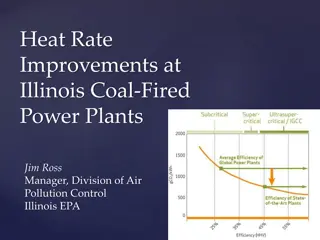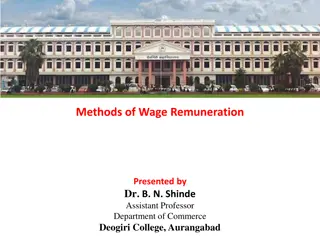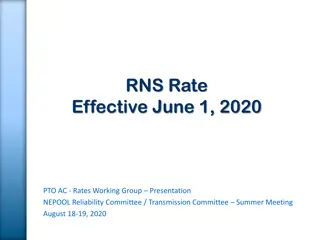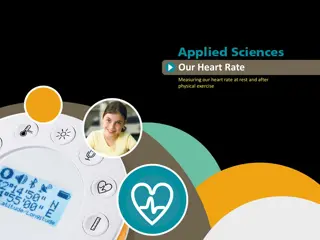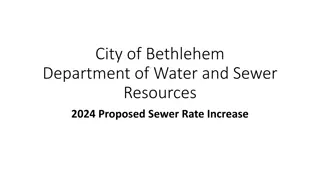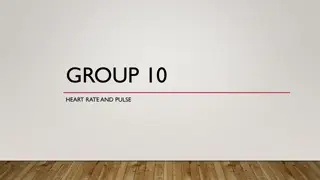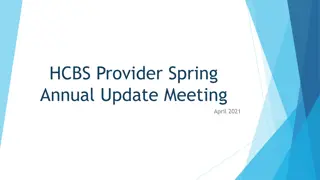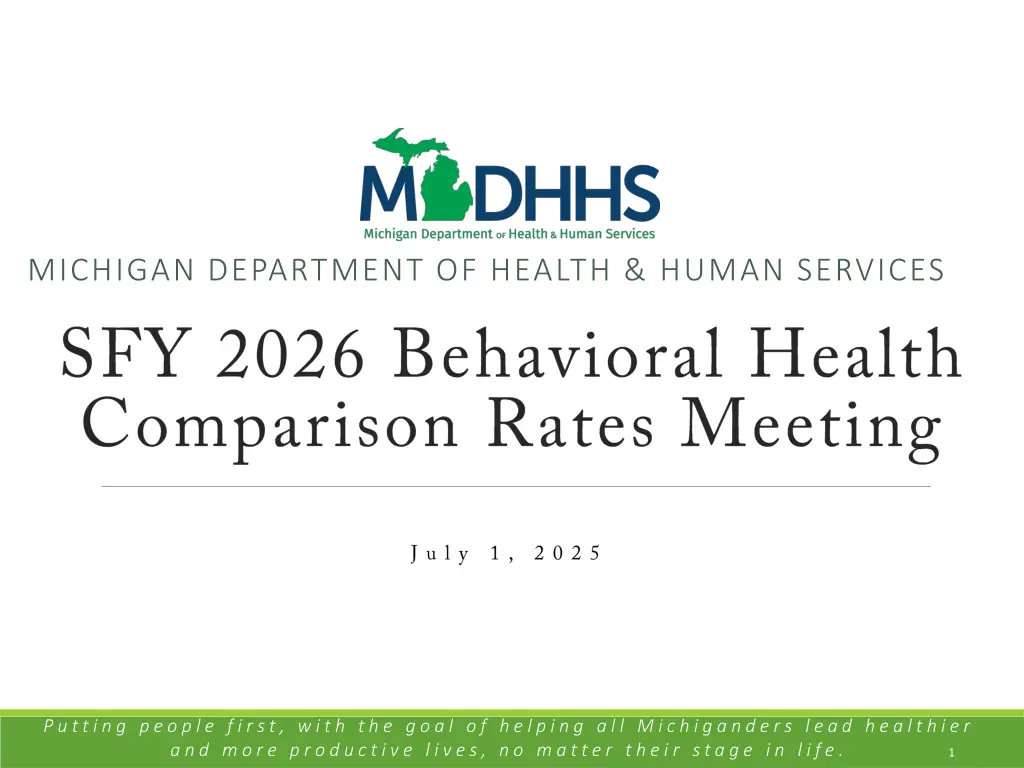
Michigan Health Services - Behavioral Health Comparison Rate Development
"Michigan Department of Health & Human Services prioritizes improving health outcomes and productivity for residents. Explore the development of comparison rates for behavioral health services to enhance cost efficiency and provider payments. Join the discussion on achieving standardized rates for Medicaid services in Michigan."
Download Presentation

Please find below an Image/Link to download the presentation.
The content on the website is provided AS IS for your information and personal use only. It may not be sold, licensed, or shared on other websites without obtaining consent from the author. If you encounter any issues during the download, it is possible that the publisher has removed the file from their server.
You are allowed to download the files provided on this website for personal or commercial use, subject to the condition that they are used lawfully. All files are the property of their respective owners.
The content on the website is provided AS IS for your information and personal use only. It may not be sold, licensed, or shared on other websites without obtaining consent from the author.
E N D
Presentation Transcript
MICHIGAN DEPARTMENT OF HEALTH & HUMAN SERVICES P u t t i n g p e o p l e f i r s t , w i t h t h e g o a l o f h e l p i n g a l l M i c h i g a n d e r s l e a d h e a l t h i e r a n d m o r e p r o d u c t i v e l i v e s , n o m a t t e r t h e i r s ta g e i n l i fe . 1
Agenda Background Independent Rate Model SFY 2026 BH Comparison Rates Updates Next Steps This presentation is intended to facilitate discussion related to behavioral health comparison payment rate development and is not complete without oral comment. 2
Background This presentation is intended to facilitate discussion related to behavioral health comparison payment rate development and is not complete without oral comment. 3
Behavioral Health Comparison Rate Development Purpose: To capture and document the average expected costs a reasonably efficient Michigan provider might incur while delivering a service. To better understand the observed variation in benefit cost and administrative expenses reported by the ten prepaid inpatient health plans (PIHPs) responsible for managing the care of the behavioral health managed care program enrollees. To meet requirements under the guidelines of policy bulletin 21-39 , Section 964 in Public Act 166 of 2020 , and Public Act 87 of 2021 by developing standardized comparison rates for Medicaid behavioral health supports and services. This presentation is intended to facilitate discussion related to behavioral health comparison payment rate development and is not complete without oral comment. 4
Intended Use of Comparison Rates The term comparison rates is used in this project for the following reasons: MDHHS is not currently considering the broad adoption of comparison rates developed under this project as a state fee-for-service fee schedule or a state-directed payment under managed care. Absent future state policy changes, the comparison rates will not be directly incorporated into the behavioral health managed care capitation rate calculations. Intended Use: Evaluate variation in provider payments by comparing actual payment rates to comparison benchmark rates Improve transparency in analysis and communication between MDHHS, their contracted providers, and other stakeholders. Provide better insight into the administrative costs associated with related services incurred across the system. The long-term goal of this project is to develop a process to better understand future cost changes in the behavioral health system and to allow for potential updates to the comparison rates as needed. This presentation is intended to facilitate discussion related to behavioral health comparison payment rate development and is not complete without oral comment. 5
Independent Rate Model This presentation is intended to facilitate discussion related to behavioral health comparison payment rate development and is not complete without oral comment. 6
Independent Rate Model Approach The IRM approach builds rates from the "ground up" using a set of assumptions for key cost inputs, as opposed to relying on actual costs incurred from a prior period. Rates are developed independently from actual costs incurred, which facilitates an understanding of the resulting comparison rates under different assumptions. Key assumptions are updated annually using data from the Provider Staffing and Expense Survey, data from the Bureau of Labor Statistics (BLS), and data provided by MDHHS, stakeholders, and other national data sources. It is certain that actual individual provider cost experience will not conform exactly to the assumptions used to develop the comparison rates. Actual amounts will differ from projected amounts to the extent that actual experience deviates from expected experience. This presentation is intended to facilitate discussion related to behavioral health comparison payment rate development and is not complete without oral comment. 7
Independent Rate Model Components Direct Service Employee Salaries & Wages Transportation & Fleet Vehicle Expenses Administration, Program Support & Overhead + + + Employee Related Expenses = Unit Service Rate Expenses related to ownership, maintenance and operation of vehicles Mileage paid to employees for use of own vehicles Direct Service Staff Time Direct Supervisor Time Wage Rates Paid Time Off Assumptions Ratio of Staff to Persons Served Employee-Related Taxes and Fees Employee Benefits Facility costs Provider administration Provider program support All other operating expenses This presentation is intended to facilitate discussion related to behavioral health comparison payment rate development and is not complete without oral comment. 8
Independent Rate Model Types Rate Model Type Example Procedures Model 1: Per unit rate model - One clinical staff person providing care on a per unit basis (e.g., 15 minutes) with support from a supervisor. H2015 Community Living Supports (per 15 minutes) Model 2: Caseload rate model - Determine monthly, then convert to service unit based on assumptions related to the average number of individuals served and/or units provided during the month. H0039 Assertive Community Treatment (ACT) Model 3: Shift-based rate model - Used for services when more than one individual is served, typically in a residential or crisis setting, where clinical staff are expected to be on-site for scheduled periods or shifts, set up to provide service coverage over an extended period, or on a 24/7 basis. H0018W5 (Medium size) Alcohol and/or drug services; short term residential ASAM 3.5 This presentation is intended to facilitate discussion related to behavioral health comparison payment rate development and is not complete without oral comment. 9
SFY 2026 BH Comparison Rate Updates This presentation is intended to facilitate discussion related to behavioral health comparison payment rate development and is not complete without oral comment. 10
Provider Staffing and Expense Survey Overview Q4 2024 Q2 2025 June July 2025 Q1 2025 Present comparison rate and survey results to providers Collect MDHHS and provider feedback on the comparison rate report Deliver final comparison rate report with incorporated feedback Collaborate with MMDHS to update survey Work with key stakeholders to refine updated survey Review survey responses Update rate model according to new year of data and survey responses Develop comparison rate report and documentation of results Administer updated survey Provide instruction and training materials for combined survey Respond to provider questions (FAQs, email, phone calls) This presentation is intended to facilitate discussion related to behavioral health comparison payment rate development and is not complete without oral comment. 11
2025 Provider Survey Response Overview Total Responses Total Staff 2025 Provider Survey 2025 Provider Survey 2024 Provider Survey 2024 Provider Survey Non-CMHSPs 38,073 30,235 506 558 CMHSPs 28 27 688 3,271 Reported values for 2025 Provider Survey do not include incomplete surveys, provider expense template results provided by entities not required to complete the survey (fiduciary intermediaries or hospitals), or surveys received after March 31, 2025, in the SFY 2026 Comparison Rate development. This presentation is intended to facilitate discussion related to behavioral health comparison payment rate development and is not complete without oral comment. 12
Key Model Assumptions and Updates From SFY 2025 to SFY 2026 Category SFY 2025 Assumption SFY 2026 Assumption Wages 2024 Provider Staffing and Expense Survey Data and BLS Data published in May 2024 2025 Provider Staffing and Expense Survey Data and BLS Data published in May 2025 Network providers excluding CMHSPs1 Network providers excluding CMHSPs1 Providers Reflected in Wage Development Administrative Load 2024 Provider Staffing and Expense Survey Data Average 2024 and 2025 Provider Staffing and Expense Survey Data Rate Ranges Single comparison rate for each service Low and high rates illustrated for select services Minimum Wage Increase and ESTA Requirements No considerations made Review minimum wage as of February 2025 on provider survey data Ensure PTO assumptions align with ESTA requirements effective February 2025 1CMHSPs were excluded from the development of SFY 2026 comparison rates to better reflect the entities delivering these services (providers contracting with PIHPs or CMHSPs) Note: BH Comparison Rates have been developed since SFY 2021 using the data collected and required by Policy 21-39 This presentation is intended to facilitate discussion related to behavioral health comparison payment rate development and is not complete without oral comment. 13
Wage Analysis Approach Goal: Use Provider Reported Wages to the Greatest Extent Possible Compile Surveys - Aggregate all provider submitted surveys Identify ABA Staff behavioral technician, BCBA, BCBA-D, BCaBA, licensed behavior analyst, QBHP: BACB Approved Degree, licensed psychologist, limited licensed psychologist Outlier Analysis - Responses that were two standard deviations above/below the median were not included Credibility Analysis - Used Classical Credibility Theory to determine number of responses needed for full credibility Wage Compilation - Blended provider survey wages with BLS wages using credibility weights. Trend was applied at 2.2% annually for HM modifiers (consistent with the prior year) and 3.7% annually for all other provider modifiers (FRED) Only surveys where respondents listed both the number of FTEs and the average wage were used in the wage analysis. This presentation is intended to facilitate discussion related to behavioral health comparison payment rate development and is not complete without oral comment. 14
Wages Overview Median Wage Example Provider Grouping Median Provider Survey Median Wages from BLS Median Credibility Weighted Wages Description Survey Credibility AH Clinical Psychologist 42.9% $ 54.84 $ 41.55 $ 47.25 HM Less Than Bachelor's Level 100.0% 17.73 18.03 17.73 HM Less Than Bachelor's Level ABA 100.0% 19.30 19.69 19.30 HN Bachelor's Level 33.2% 25.61 32.19 25.61 HN Bachelor's Level ABA 100.0% 33.57 29.01 30.53 HO Master's Level 100.0% 32.02 33.63 32.02 HO Master's Level ABA 100.0% 38.93 34.82 38.93 TD Registered Nurse 100.0% 40.82 45.02 40.82 TE Licensed Practical Nurse 100.0% 32.01 33.04 32.01 WR Peer Recovery Coach 100.0% 19.25 16.99 19.25 WS Certified Peer Specialist 100.0% 19.88 16.99 19.88 BLS wage information retrieved from: https://www.bls.gov/news.release/pdf/ecec.pdf Median wages for other provider groupings can be found in Appendix A This presentation is intended to facilitate discussion related to behavioral health comparison payment rate development and is not complete without oral comment. 15
Health Insurance Assumption for the HM Modifier Utilization of BLS data from all counties utilize BLS data from all Michigan counties and weigh health insurance amounts reported by county population. Assumption of expanded bronze coverage utilize health insurance costs from expanded bronze plans only to better reflect the coverage assumed to be provided to HM modifier employees and trend using the Milliman Medical Index (average of $4,488 annually with a midpoint of December 10, 2024, trended at 6.10% annually, to be approximately $4,849 annually for SFY 2026). Reflect enrollment frequency utilize Provider Survey of non-HM modifier workers to assume 64% of direct care workers utilize employer sponsored insurance. Calculate anticipated average insurance cost for SFY 2026 multiply the SFY 2026 projected expanded bronze coverage by the enrollment frequency to develop the projected average annual insurance cost per HM employee of $3,103 in SFY 2026. Health plan cost information retrieved from: https://www.healthcare.gov/health-plan-information/ The take-up percentage observed from 2024 Provider Survey results was 32% for the HM provider modifier. MDHHS has assumed a higher take-up rate value to promote providers offering health insurance benefits to their direct care staff. We did not collect this data in the 2025 Provider Survey. This presentation is intended to facilitate discussion related to behavioral health comparison payment rate development and is not complete without oral comment. 16
Administration / Program Support / Overhead For SFY 2026, administrative loading is calculated from the blended provider surveys from 2024 and 2025 to alleviate significant year-over-year fluctuations. The median administrative loading (administrative costs divided by overall costs) for each of the lines of business were developed using 2024 and 2025 Provider Survey submissions for providers with over $5M in Medicaid behavioral health expenditures (i.e., revenues received from CMHSPs/PIHPs). Procedure codes have been updated to use one of the below line of business assumptions based on which line of business MDHHS sees as most suitable (see Appendix B) Line of Business 2024 Survey 2025 Survey Blended for SFY 2026 Support services 15.6% 16.5% 16.1% Other services 21.7% 19.2% 20.4% Licensed residential per diem 12.1% 15.7% 13.9% MH/SUD (residential)/detox per diem 27.1% 25.5% 26.3% MH and SUD services (clinical) 23.0% 25.0% 24.0% ABA services 23.7% 17.7% 20.7% Composite 19.5% 19.0% 19.3% This presentation is intended to facilitate discussion related to behavioral health comparison payment rate development and is not complete without oral comment. 17
Comparison Rate Ranges Less than Bachelor s Low Rate Assumptions No insurance take-up 15 days paid holidays and PTO (decrease from 25 days) Maintains minimum requirement for ESTA No indirect time or transportation time for H2015, H0043, T2026, T2027, and T1005 Less than Bachelor s High Rate Assumptions All assumptions as presented in prior slides Procedure Code Service Description Low Rate High Rate H0043 Comprehensive Community Support Services (per diem) $ 361.56 $ 487.37 H0043TG Comprehensive Community Support Services (per diem) - 16 or more hours 571.97 746.62 H2014 Skills training and development 10.96 12.13 H2015 Comprehensive Community Support Services (per 15 minutes) 7.41 11.23 H2015UJ Comprehensive Community Support Services - Overnight Health & Safety 6.48 8.03 T1005HM Respite care services - Less Than Bachelor's Level 7.6 9.36 T2026 Overnight Health and Safety (per diem) 204.79 253.7 T2027 Overnight Health and Safety (per 15 minutes) 6.48 8.03 18 This presentation is intended to facilitate discussion related to behavioral health comparison payment rate development and is not complete without oral comment.
Example Model 1 Community Support Services) Model 1 H2015 (Comprehensive Low High Ref. Description DCW Supervisor Total DCW Supervisor Total Notes A Average minutes of direct time per unit 15.00 15.00 B Average minutes of indirect time per unit - 1.50 C Average minutes of transportation time per unit - 2.10 D Total minutes per unit 15.00 18.60 D = A + B + C E Staffing ratio 1.00 1.00 F Supervisor span of control 10.00 10.00 G Supervisor time per DCW 1.50 1.86 G = D / F H PTO/training/conference time adjustment factor 11.8% 11.8% 16.9% 16.9% Supervisor: I = G / E * ( 1 + H ) Clinician: I = D / E * ( 1 + H ) I Adjusted total minutes per unit 16.77 1.68 21.73 2.17 J Hourly wage $ 17.73 $ 19.21 $ 17.73 $ 19.21 K Total wages expense per unit $ 4.96 $ 0.54 $ 5.49 $ 6.42 $ 0.70 $ 7.12 K = I * J / 60 L Employee related expense (ERE) percentage 16.1% 15.9% 24.6% 23.7% M Total ERE expense per unit $ 0.80 $ 0.09 $ 0.89 $ 1.58 $ 0.17 $ 1.74 M = K * L N Estimated average MPH - 32.95 O Estimated miles driven per unit - 1.15 O = N * C / 60 / E P Federal reimbursement rate $0.70 $0.70 Q Mileage reimbursement or vehicle costs per unit $0.00 $0.81 Q = O * P R On-call expenses $ 0.00 $ 0.00 S Drug cost $ 0.00 $ 0.00 T Drug administration $ 0.00 $ 0.00 U Administration / program support / overhead 13.9% 13.9% V = U * ( K + M + Q + R + S + T ) / ( 1 - U ) V Administration expenses $ 1.03 $ 1.56 W Rate per 15 minutes $7.41 $11.23 W = ( K + M + Q + R + S + T + V ) The DCW worker has been assigned the HM provider modifier (less than bachelor s level) and receives the 50th percentile wage level within the grouping. The supervisor has also been assigned the HM provider modifier and receives the 75th percentile wage level in the grouping This presentation is intended to facilitate discussion related to behavioral health comparison payment rate development and is not complete without oral comment. 19
Example Model 2 Treatment) Model 2 H0039 (Assertive Community Ref. Description Psychiatrist Registered Nurse Team Leader QMHP Peer Specialist Paraprofessional Total Notes A Hourly wage $ 157.85 $ 40.82 $ 32.02 $ 25.61 $ 19.88 $ 17.73 B Number of employees 0.33 1.00 1.00 2.00 1.00 1.00 C Total wages expense per month $ 9,029 $ 7,075 $ 5,550 $ 8,879 $ 3,446 $ 3,073 $ 37,053 C = A * B * 2080 / 12 Employee related expense (ERE) percentage D 13.4% 24.1% 27.0% 30.3% 35.2% 24.6% E Total ERE expense per month $ 1,208 $ 1,704 $ 1,497 $ 2,694 $ 1,212 $ 755 $ 9,070 E = C * D F Federal reimbursement rate $ 0.70 G Average miles driven per month 10,000 Monthly mileage reimbursement or vehicle costs H $ 7,000 H = F * G Administration / program support / overhead I 20.4% J Monthly administration expenses $ 13,645 J = I * (C + E + H ) / ( 1 - I ) K Monthly costs $ 66,767 K = C + E + H + J Average number of recipients per team L 60 M Monthly cost per beneficiary $1,112.79 M =K / L Average units per month per beneficiary N 18 O Total Rate per Diem $61.82 O = M / N Team members shown include a variety of provider modifiers ranging from Paraprofessional at HM (less than bachelor s level) to the Psychiatrist at AF (Specialty Physician) This presentation is intended to facilitate discussion related to behavioral health comparison payment rate development and is not complete without oral comment. 20
Example Model 3 and/or drug services; long-term residential) Therapists - Bachelor's Model 3 H0019 W5 Medium (Alcohol Therapists - Master's Doctor On- Call Ref. Description DCW Nurses Physicians Director Total Notes A First shift workers - 1.50 1.00 1.00 1.00 0.25 1.00 B Second shift workers - - 1.00 0.50 0.50 0.50 1.00 C Third shift workers - - 1.00 0.50 0.50 0.50 1.00 D Weekend first shift workers - - 1.00 0.50 0.50 0.50 1.00 E Weekend second shift workers - - 1.00 0.25 0.25 0.25 1.00 F Weekend third shift workers - - 1.00 0.50 0.50 0.50 1.00 G = {[( A + B + C ) * 5] + [( D + E + F ) * 2]} * 8 G Total weekly hours 188.00 100.00 100.00 100.00 128.00 10.00 40.00 H Number of individuals served 20 I PTO/training/conference time adjustment factor 16.9% 15.6% 16.9% 16.9% 16.9% 16.9% 16.9% J Adjusted total hours of time per week 219.69 115.56 116.85 116.85 149.57 11.69 46.74 J = G * ( 1 + I ) K Hourly wage $ 17.73 $ 25.61 $ 32.02 $ 40.82 $ 3.00 $ 157.85 $ 35.32 L Total wages expense per week $ 3,895 $ 2,960 $ 3,742 $ 4,770 $ 449 $ 1,845 $ 1,651 L = J * K M Holidays worked - - - - - - 10 Percent of non-holiday hours paid at time and a half N 7.3% 0.0% 0.0% 0.0% 0.0% 0.0% 0.0% O Percent of total hours paid at time and a half 9.8% 0.0% 0.0% 0.0% 0.0% 0.0% 0.0% O = ( ( 365.25 - M ) * N + M ) / 365.25 Direct care wage adjusted for overtime and holidays per week P $ 4,085.20 $ 2,959.74 $ 3,741.76 $ 4,769.98 $ 448.72 $ 1,844.54 $ 1,650.70 $ 19,500.64 P = L * ( 1 - O ) + L * O * 1.5 Q Employee related expense (ERE) percentage 24.6% 30.3% 27.0% 24.1% 22.6% 13.4% 25.7% R Total ERE expense per week $ 1,003.44 $ 897.91 $ 1,009.31 $ 1,148.43 $ 101.59 $ 246.85 $ 424.56 $ 4,832.09 R = P * Q S Mileage reimbursement or vehicle costs per week $ 202.98 T Administration / program support / overhead 26.3% U Administration expenses per week $8,767.01 U = T * ( P + R + S ) / ( 1 - T ) V Medication costs $ 0.00 W Caseload efficiency 100.0% X Units per week 6.99 Y = ( ( ( P + R + S + U ) / W ) + V ) / X ) / H Y Rate per Diem $238.06 This presentation is intended to facilitate discussion related to behavioral health comparison payment rate development and is not complete without oral comment. 21
Next Steps This presentation is intended to facilitate discussion related to behavioral health comparison payment rate development and is not complete without oral comment. 22
Report Distribution and Feedback PIHPs and behavioral health providers are encouraged to read the SFY 2026 BH Comparison Rates Report on the MDHHS website once it s released The report will be added to the website alongside the prior reports: Reporting Requirements (michigan.gov) under the Policy 21-39 Reporting Requirements dropdown Stakeholders will be notified once the report is released PIHPs and behavioral health providers can submit questions and comments about the SFY 2026 BH Comparison Rates by emailing feedback to the bh.provider.survey@milliman.com inbox Comments and questions will be due two weeks after distribution of the report Any questions or comments can be sent to the bh.provider.survey@milliman.com inbox This presentation is intended to facilitate discussion related to behavioral health comparison payment rate development and is not complete without oral comment. 23
Appendices This presentation is intended to facilitate discussion related to behavioral health comparison payment rate development and is not complete without oral comment. 24
Appendix A Median Wages (All Provider Groupings) Survey Credibility Median Provider Survey Median Wages from BLS Median Credibility Weighted Wages Provider Grouping Description AE Dietician 92.8% $ 33.76 $ 38.20 34.08 AF Specialty Physician 47.5% 157.85 - 157.85 AG Physician 52.4% 125.56 104.00 115.31 AH Clinical Psychologist 42.9% 54.84 41.55 47.25 AH Clinical Psychologist ABA 42.9% 54.84 41.55 47.25 CO Occupational Therapist Assistant 76.1% 29.60 31.35 30.02 CQ Physical Therapist Assistant 53.5% 34.72 30.63 32.82 HM Less Than Bachelor's Level 100.0% 17.73 18.03 17.73 HM Less Than Bachelor's Level ABA 100.0% 19.30 19.69 19.30 HN Bachelor's Level 100.0% 25.61 32.19 25.61 HN Bachelor's Level ABA 33.2% 33.57 29.01 30.53 Benefits information retrieved from: https://www.bls.gov/current/oes_mi.htm Provider Grouping AF utilized Provider Survey wages only despite results not being fully credible due to the selected BLS job title not having data for Michigan This presentation is intended to facilitate discussion related to behavioral health comparison payment rate development and is not complete without oral comment. 25
Appendix A Median Wages (All Provider Groupings) cont. Survey Credibility Median Provider Survey Median Wages from BLS Median Credibility Weighted Wages Provider Grouping Description HO Master's Level 100.0% 32.02 33.63 32.02 HO Master's Level ABA 100.0% 38.93 34.82 38.93 HP Doctoral Level 35.7% 25.63 41.55 35.87 HP Doctoral Level ABA 0.0% 84.25 41.55 41.55 SA Physician Assistant 100.0% 68.23 66.73 68.23 TD Registered Nurse 100.0% 40.82 45.02 40.82 TE Licensed Practical Nurse 100.0% 32.01 33.04 32.01 WP Trained Parent 28.6% 21.84 16.99 18.37 WQ Independent Facilitator 55.4% - 16.99 16.99 WR Peer Recovery Coach 100.0% 19.25 16.99 19.25 WS Certified Peer Specialist 100.0% 19.88 16.99 19.88 WT Youth Peer Specialist 100.0% 17.84 16.99 17.84 WU DD Peer Mentor 42.4% 18.90 16.99 17.80 Benefits information retrieved from: https://www.bls.gov/current/oes_mi.htm This presentation is intended to facilitate discussion related to behavioral health comparison payment rate development and is not complete without oral comment. 26
Appendix B - Line of Business to Service Category Mapping Selected Administrative Loading Service Category HCPCS Assigned Line of Business Additional Support Services Support Services 16.1% H0036, H0038, H0045, H2030, H2033, S5116, S5150, S5151, T1005 Applied Behavior Analysis Services Applied Behavioral Analysis/Autism Services 20.7% 0373T, 97151, 97153, 97154, 97155, 97156, 97157, 97158 Assertive Community Treatment (ACT) Other Services 20.4% H0039 Assessments and Testing Applied Behavioral Analysis/Autism Services 20.7% 0362T, H0001, H0002, H0031, T1001 Case Management / Treatment Planning Support Services 16.1% H0032 Community Living Supports Licensed Residential Per Diem (Procedure Codes H2016/T1020) 13.9% H0043, H2015, H2016+T1020, T2026, T2027 Evaluation and Management Mental Health and SUD Services (Clinical) 24.0% 99205, 99211, 99213, 99214, 99215 Medication Administration Other Services 20.4% 96372 Medication Assisted Treatment Mental Health and SUD Services (Clinical) 24.0% G2076, G2077, G2078, H0020 Other Other Services 20.4% S5110, S5111, T1002 Psychiatric diagnostic evaluation Mental Health and SUD Services (Clinical) 24.0% 90791, 90792 Psychotherapy Mental Health and SUD Services (Clinical) 24.0% 90832, 90834, 90837, 90846, 90847, 90849, 90853 Residential Services MH / SUD (Residential) / Detox Per Diem 26.3% H0019 Skill Building Support Services 16.1% H2014 Therapeutic Behavioral Services Other Services 20.4% H2019 Vocational Supports Support Services 16.1% H2023 Withdrawal Management Mental Health and SUD Services (Clinical) 24.0% H0010, H0012 Selected administrative loading reflects blended survey results from 2024 and 2025 survey submissions for providers with over $5M in Medicaid behavioral health expenditures. This presentation is intended to facilitate discussion related to behavioral health comparison payment rate development and is not complete without oral comment. 27
Thank you! This presentation is intended to facilitate discussion related to behavioral health comparison payment rate development and is not complete without oral comment. 28
Limitations The information contained in this presentation is prepared solely for the internal business use of State of Michigan, Department of Health and Human Services (MDHHS). Milliman's work may not be provided to third parties without Milliman's prior written consent. Milliman does not intend to benefit any third party recipient of its work product, even if Milliman consents to the release of its work product to such third party. The recommendations or analysis in this presentation does not constitute legal advice. We recommend that users of this material consult with their own legal counsel regarding interpretation of applicable laws, regulations, and requirements. Milliman has developed certain models to estimate the values included in this correspondence. We have reviewed the models, including their inputs, calculations, and outputs for consistency, reasonableness, and appropriateness to the intended purpose and in compliance with generally accepted actuarial practice and relevant actuarial standards of practice (ASOP). The models rely on data and information as input to the models. We have relied upon certain data and information provided by the client for this purpose and accepted it without audit. To the extent that the data and information provided is not accurate, or is not complete, the values provided in this correspondence may likewise be inaccurate or incomplete. The models, including all input, calculations, and output may not be appropriate for any other purpose. Differences between our projections and actual amounts depend on the extent to which future experience conforms to the assumptions made for this analysis. It is certain that actual experience will not conform exactly to the assumptions used in this analysis. Actual amounts will differ from projected amounts to the extent that actual experience deviates from expected experience. Guidelines issued by the American Academy of Actuaries require actuaries to include their professional qualifications in all actuarial communications. The authors of the actuarial slides in this presentation, Jeremy Cunningham, Jason Howard, Teresa Wilder, and John Belanger, are members of the American Academy of Actuaries, and meet the qualification standards for performing the analyses in this report. This presentation is intended to facilitate discussion related to behavioral health comparison payment rate development and is not complete without oral comment. 29


